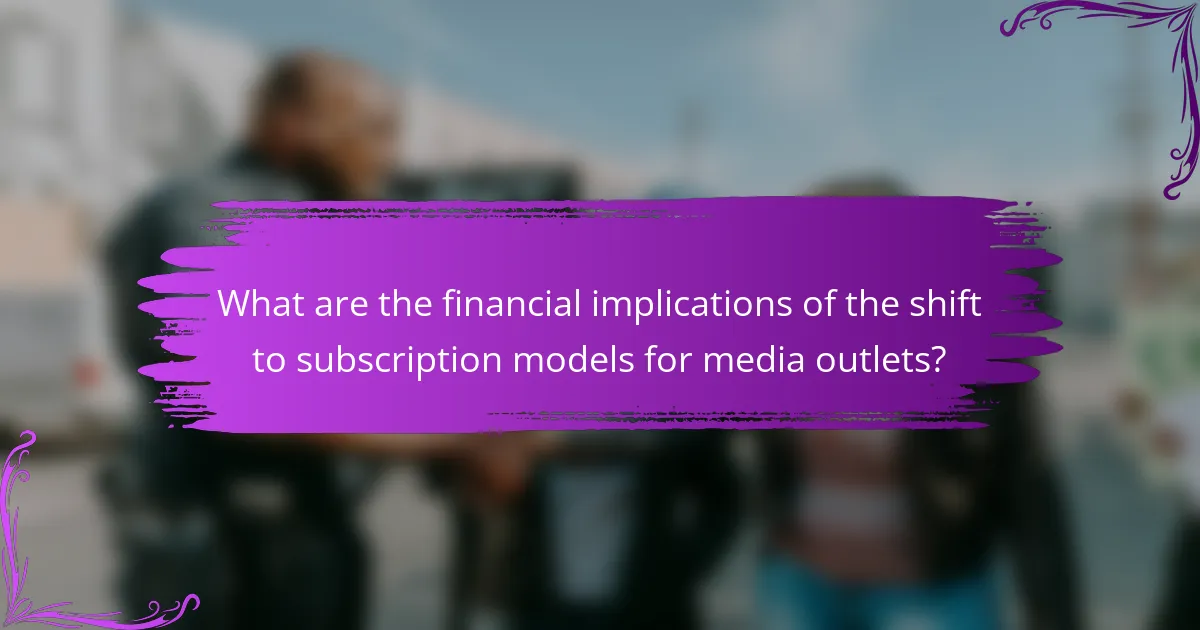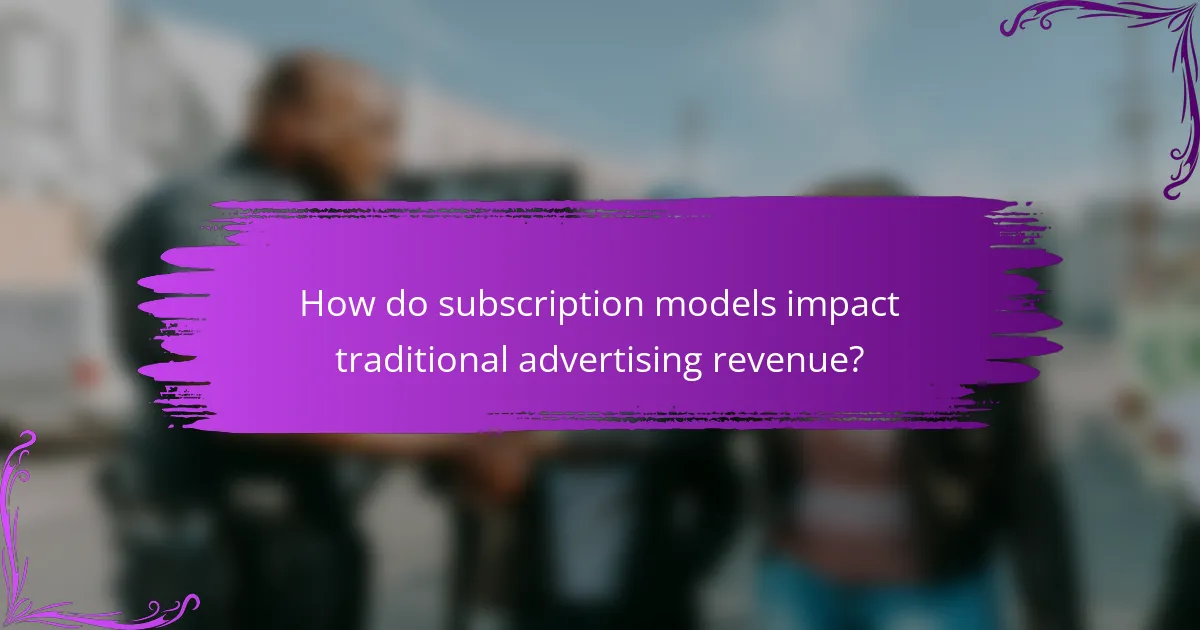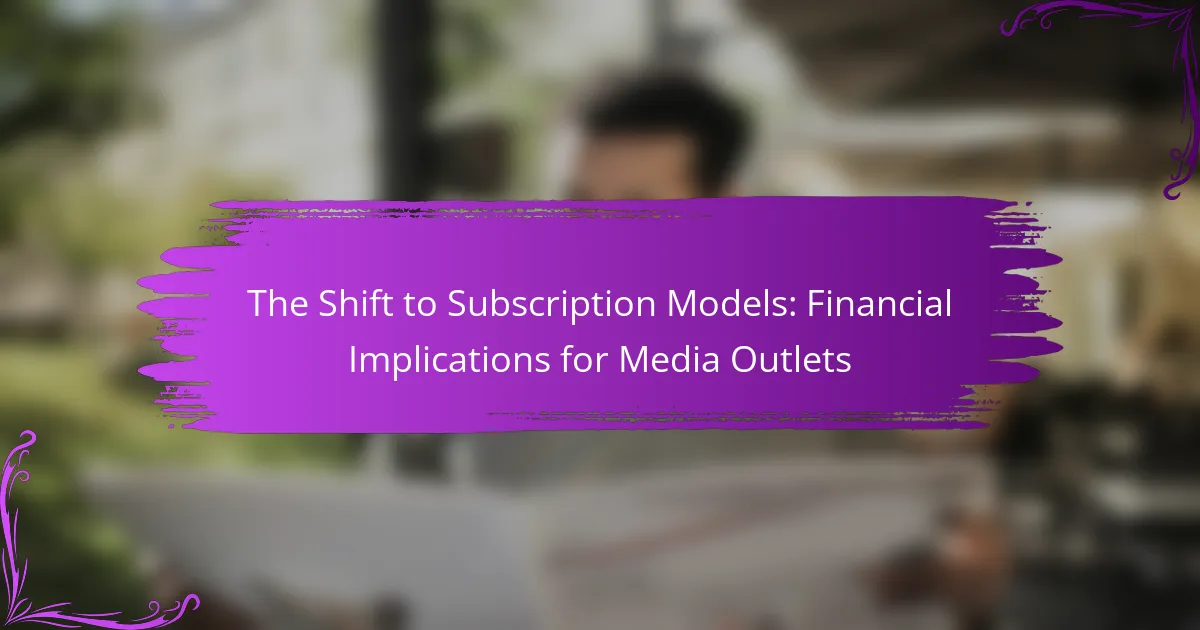
What are the financial implications of the shift to subscription models for media outlets?
The shift to subscription models for media outlets significantly impacts their financial stability. This model often leads to more predictable revenue streams compared to traditional advertising. Subscription revenue can enhance profitability, as it reduces reliance on fluctuating ad markets. Moreover, media outlets can foster direct relationships with their audience, improving customer loyalty and retention. According to a 2021 report by PwC, subscription-based media companies saw revenue growth of 25% year-over-year. This growth indicates a strong market preference for subscription services. However, the transition requires upfront investment in technology and content creation. Overall, the shift to subscription models can lead to sustainable financial health for media outlets.
How has the media landscape changed with the rise of subscription models?
The media landscape has shifted significantly due to the rise of subscription models. Traditional advertising revenue has declined as consumers prefer ad-free experiences. This shift has led media outlets to focus on building loyal subscriber bases. Subscription models allow for direct revenue from consumers, enhancing financial stability. Content quality has improved as outlets prioritize value to retain subscribers. Data analytics have become crucial for tailoring content to subscriber preferences. The competition among media outlets has intensified, prompting innovation in content delivery. Overall, subscription models have transformed revenue strategies and audience engagement in the media industry.
What factors have contributed to the shift towards subscription models?
The shift towards subscription models has been driven by consumer demand for convenience and personalized content. Consumers increasingly prefer access to a wide range of services without large upfront costs. This model allows for lower financial commitment while providing ongoing access. Additionally, the rise of digital platforms has facilitated easy subscription management. Companies benefit from predictable revenue streams, enhancing financial stability. Data shows that subscription services have grown by 300% in the past decade across various industries. This trend reflects changing consumer behavior towards valuing access over ownership. Furthermore, advancements in technology have made it easier for businesses to implement subscription systems efficiently.
How do consumer preferences influence subscription adoption?
Consumer preferences significantly influence subscription adoption by determining the perceived value of services. When consumers prioritize convenience, personalized content, or exclusive access, they are more likely to subscribe. Research indicates that 66% of consumers prefer subscription services that offer tailored experiences. Additionally, price sensitivity plays a crucial role; consumers are more inclined to adopt subscriptions that align with their budget. A survey found that 70% of respondents would consider canceling subscriptions if prices increased. Therefore, understanding consumer preferences helps media outlets design attractive subscription models that enhance adoption rates.
What are the potential benefits of subscription models for media outlets?
Subscription models for media outlets provide a steady revenue stream. This financial stability allows for improved content quality and investment in journalism. Subscribers often feel more engaged with the content they pay for. This engagement can lead to higher customer loyalty and retention rates. Data shows that outlets with subscription models can reduce reliance on advertising revenue. A 2021 study by the Reuters Institute found that 60% of digital news consumers are willing to pay for news. Subscription models can also facilitate direct relationships with audiences. This direct connection enables tailored content and marketing strategies.
How do subscription models enhance revenue stability?
Subscription models enhance revenue stability by providing predictable and recurring income streams. This model allows businesses to forecast revenue more accurately. It reduces reliance on one-time purchases, which can fluctuate. For instance, a study by McKinsey found that subscription businesses grow revenues 5-8 times faster than traditional models. Additionally, subscribers tend to have higher lifetime values than one-time customers. This results in a more stable cash flow for companies. As a result, subscription models create a more resilient financial structure.
What role does customer loyalty play in the success of subscription models?
Customer loyalty is crucial for the success of subscription models. It directly impacts customer retention rates. High retention leads to predictable revenue streams. Loyal customers are more likely to renew their subscriptions. They also tend to spend more over time. According to a study by Bain & Company, increasing customer retention by just 5% can boost profits by 25% to 95%. This demonstrates the financial benefits of loyalty in subscription models. Additionally, loyal customers often act as brand advocates. They can refer new subscribers, further enhancing growth. Thus, customer loyalty significantly contributes to the sustainability and profitability of subscription-based businesses.
What challenges do media outlets face when implementing subscription models?
Media outlets face several challenges when implementing subscription models. One major challenge is customer acquisition. Attracting new subscribers often requires significant marketing investment. Another challenge is customer retention. Media outlets must continuously provide value to keep subscribers engaged. Pricing strategies also pose difficulties. Setting the right price can determine the success of the subscription model. Additionally, competition from free content affects market dynamics. Consumers may prefer free alternatives over paid subscriptions. There is also the challenge of technology integration. Media outlets need robust platforms to manage subscriptions effectively. Data privacy concerns further complicate subscription models. Subscribers may hesitate to share personal information. These challenges collectively impact the financial viability of subscription models for media outlets.
How do pricing strategies affect subscriber acquisition?
Pricing strategies significantly influence subscriber acquisition. Competitive pricing can attract more subscribers by offering perceived value. For instance, introductory discounts or tiered pricing models can lower entry barriers. Research shows that 70% of consumers are more likely to subscribe when offered a lower initial price. Psychological pricing, such as setting prices just below a round number, can also enhance appeal. Additionally, subscription bundles that combine multiple services can increase perceived value. Overall, effective pricing strategies can create a compelling proposition for potential subscribers.
What technological barriers must be overcome for successful implementation?
Technological barriers for successful implementation of subscription models in media outlets include data security, payment processing, and user experience. Data security is crucial to protect subscriber information from breaches. Payment processing systems must be reliable and efficient to handle recurring transactions. User experience needs to be seamless to encourage subscriptions and reduce churn. Additionally, integration with existing systems can pose challenges. According to a 2021 report by McKinsey, 70% of media companies struggle with these technological issues during implementation.

How do subscription models impact traditional advertising revenue?
Subscription models reduce traditional advertising revenue by shifting consumer spending from ad-supported content to paid subscriptions. This transition decreases the audience size for advertisers, as fewer users access free content. According to a 2021 study by PwC, U.S. consumers spend an average of $47 per month on subscription services, impacting ad revenue streams. As subscriptions grow, media outlets prioritize subscriber engagement over advertising, leading to less ad inventory. For example, The New York Times reported a significant decline in ad revenue as its subscription base expanded. Consequently, traditional advertising revenue faces pressure as the media landscape evolves.
What changes occur in advertising strategies due to subscription models?
Advertising strategies shift significantly due to subscription models. Subscription models reduce reliance on traditional advertising revenue. This leads to a focus on creating value for subscribers. Advertisers target specific audiences more effectively. Data analytics play a crucial role in understanding subscriber preferences. Personalization of ads becomes essential in this new framework. Brands seek long-term relationships over short-term gains. The effectiveness of ads is measured by subscriber engagement rather than impressions.
How do subscription models alter audience targeting for advertisers?
Subscription models change audience targeting for advertisers by providing detailed user data. Advertisers gain insights into subscriber preferences and behaviors. This data allows for more precise audience segmentation. Advertisers can tailor their messages to specific subscriber interests. Subscription models reduce reliance on broad demographic targeting. This shift leads to higher engagement rates for targeted ads. Research shows that personalized advertising increases conversion rates significantly. Advertisers benefit from a clearer understanding of their audience’s willingness to pay for content.
What is the effect on ad revenue compared to traditional models?
The shift to subscription models typically results in a decrease in ad revenue compared to traditional models. Traditional models rely heavily on advertising as the primary revenue source. With subscriptions, media outlets prioritize direct payments from consumers. This shift can lead to a more stable revenue stream but may reduce the overall ad impressions available. For instance, according to a report by PwC, digital ad revenue growth is slowing as more users opt for ad-free experiences. Additionally, the Interactive Advertising Bureau noted a 20% decline in ad revenue for some publishers transitioning to subscription models.
How can media outlets balance subscriptions and advertising?
Media outlets can balance subscriptions and advertising by implementing a hybrid revenue model. This model allows them to generate income from both subscriptions and ad sales. They can offer exclusive content to subscribers while maintaining ad-supported free access for non-subscribers. This approach attracts a broader audience and increases overall engagement.
Data from the Pew Research Center indicates that 46% of U.S. adults reported paying for news in 2021. This statistic highlights the potential for subscription revenue. Additionally, 70% of consumers prefer ad-free experiences when they pay for content. Thus, media outlets can leverage this preference by creating tiered subscription options.
By analyzing user behavior, outlets can tailor advertising strategies that align with subscriber interests. This targeted approach enhances ad effectiveness and retention of subscribers. Balancing these revenue streams can lead to sustainable financial health for media organizations.
What hybrid models are emerging in the media industry?
Emerging hybrid models in the media industry include subscription-based services combined with ad-supported content. These models allow media outlets to diversify revenue streams. For example, platforms like Hulu offer both subscription tiers and ad-supported options. This approach caters to different audience preferences. Additionally, some news organizations are implementing paywalls alongside free content. This strategy aims to attract a wider readership while generating subscription revenue. Research shows that hybrid models can increase overall profitability for media companies. According to a report by PwC, companies utilizing hybrid models are better positioned for sustainable growth.
How can outlets optimize both revenue streams effectively?
Outlets can optimize both revenue streams effectively by diversifying their offerings. This includes combining subscription models with advertising revenue. For instance, outlets can provide premium content to subscribers while also maintaining ad-supported free content. Research shows that 70% of media outlets benefit from dual revenue streams. This strategy allows for broader audience reach and increased engagement. Furthermore, data analytics can help outlets understand user preferences, tailoring content and ads accordingly. By aligning content with audience interests, outlets enhance user satisfaction and retention, ultimately boosting revenue.

What best practices should media outlets follow when transitioning to subscription models?
Media outlets should prioritize audience engagement when transitioning to subscription models. Engaging with readers builds trust and loyalty. Offering exclusive content can incentivize subscriptions. Outlets should also implement tiered pricing strategies to cater to different audience segments. Clear communication about the value of subscriptions is essential. Providing free trials can encourage potential subscribers to explore the content. Data analytics should guide content strategies to meet subscriber preferences. Lastly, continuous feedback loops with subscribers can help refine offerings and improve retention.
How can media outlets effectively market their subscription offerings?
Media outlets can effectively market their subscription offerings by leveraging targeted digital marketing strategies. They should utilize data analytics to identify and understand their audience segments. Personalized email campaigns can engage potential subscribers with tailored content. Social media platforms can be used to promote exclusive offers and subscription benefits. Offering free trials or limited-time discounts can attract new subscribers. Collaborating with influencers can enhance visibility and credibility. Engaging content that highlights the value of subscriptions can drive conversions. According to a 2021 study by the Pew Research Center, 76% of Americans recognize the importance of quality journalism, indicating a market for subscription-based news services.
What strategies can be employed to retain subscribers long-term?
To retain subscribers long-term, media outlets can implement personalized content strategies. Tailoring content to individual preferences increases engagement. Regularly updating content keeps subscribers interested and reduces churn. Offering exclusive benefits, such as early access or special features, enhances perceived value.
Maintaining open communication through newsletters fosters a sense of community. Regular feedback surveys help understand subscriber needs and improve services. Competitive pricing models can also attract and retain subscribers. According to a study by PwC, 63% of consumers are willing to pay for content that meets their specific interests.
How can outlets gather and utilize subscriber feedback for improvement?
Outlets can gather and utilize subscriber feedback through surveys, direct communication, and analytics. Surveys can be distributed via email or within the platform. They enable subscribers to share their opinions on content and services. Direct communication methods include social media interactions and customer service channels. These platforms allow for real-time feedback and engagement with subscribers.
Analytics tools can track user behavior and preferences. They help identify trends in subscriber engagement and content consumption. This data can inform content strategy and service improvements. By analyzing feedback, outlets can make data-driven decisions to enhance user experience.
Research shows that 70% of customers are more likely to stay with a company that actively seeks their feedback (Source: Microsoft, 2020). This statistic highlights the importance of subscriber feedback in retaining customers and improving services.
What are common pitfalls to avoid when shifting to subscription models?
Common pitfalls to avoid when shifting to subscription models include underestimating customer acquisition costs. Many outlets fail to account for the expenses related to marketing and onboarding new subscribers. Another pitfall is neglecting existing customer retention strategies. Retaining subscribers is often more cost-effective than acquiring new ones. Additionally, outlets may overlook the importance of offering value in their subscription. If subscribers perceive low value, they are likely to cancel. Poorly defined pricing strategies can also hinder success. Setting prices too high or too low can deter potential subscribers. Lastly, failing to analyze user data can lead to missed opportunities for improvement. Regularly reviewing subscriber behavior can inform better content and service offerings.
How can media outlets prevent subscriber churn during the transition?
Media outlets can prevent subscriber churn during the transition by enhancing communication with their audience. Clear messaging about changes helps subscribers understand the value of the new model. Offering exclusive content or perks can incentivize retention. A personalized approach, such as tailored recommendations, also fosters loyalty. Implementing feedback mechanisms allows outlets to address subscriber concerns promptly. Data shows that proactive engagement can reduce churn rates significantly. According to a study by McKinsey, companies that prioritize customer experience see a 10-15% increase in retention.
What mistakes have other outlets made that should be learned from?
Many media outlets have failed to adequately communicate the value of their subscription models. This has led to subscriber dissatisfaction and high churn rates. For instance, outlets often offer limited content for free, which can devalue the paid experience. Some outlets have also neglected to invest in user experience, resulting in complicated sign-up processes. Poor customer service has been another common mistake, leading to frustrated subscribers. Additionally, failing to adapt content to audience preferences has caused some subscriptions to stagnate. Lastly, many outlets have not effectively marketed their unique selling propositions, making it hard to attract new subscribers.
What are the future trends in subscription models for media outlets?
Future trends in subscription models for media outlets include increased personalization and tiered pricing structures. Media outlets are focusing on tailoring content to individual preferences. This approach improves user engagement and satisfaction. Tiered pricing allows consumers to choose plans based on their content needs. This flexibility can attract a broader audience. Additionally, bundling services with other digital products is becoming common. This strategy enhances perceived value for subscribers. Data-driven insights will play a crucial role in shaping these models. Research indicates that personalized experiences can lead to higher retention rates. Overall, these trends reflect an evolving landscape in media subscriptions.
How might consumer behavior evolve in the coming years?
Consumer behavior is likely to evolve towards increased preference for subscription models. More consumers are valuing convenience and personalized content. This trend is driven by the proliferation of digital platforms offering tailored experiences. According to a 2021 McKinsey report, 60% of consumers expressed interest in subscription services. Additionally, younger demographics are more inclined to adopt subscription-based models. They appreciate on-demand access and flexibility. The rise of ad-free experiences is also influencing this shift. As a result, media outlets are adapting their business strategies to meet these changing preferences.
What innovations could reshape subscription models in the media industry?
Innovations that could reshape subscription models in the media industry include personalized content delivery and tiered pricing structures. Personalized content delivery uses algorithms to tailor media offerings to individual preferences. This approach increases user engagement and retention rates. Tiered pricing structures allow consumers to choose subscription levels based on their usage and content access needs. Research indicates that 70% of consumers prefer customized plans. Additionally, bundling services with other products enhances perceived value. These innovations aim to create more flexible and user-centric subscription experiences.
The main entity of the article is the shift to subscription models for media outlets. This article examines the financial implications of this transition, highlighting how subscription models can enhance revenue stability and profitability while reducing reliance on traditional advertising. It discusses the changing media landscape, factors driving the shift, consumer preferences, potential benefits, and challenges faced by media outlets. Additionally, the article explores pricing strategies, the role of customer loyalty, and emerging hybrid models, providing a comprehensive overview of best practices and future trends in subscription-based media.



